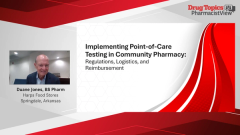
Medical Billing Strategies for Point-of-Care Testing in Community Pharmacy
A panelist discusses how medical billing for point-of-care testing represents a significant revenue opportunity for pharmacies. Further, though the process will be initially unfamiliar, pharmacists should learn and control it rather than outsourcing it.
Episodes in this series

Reimbursement and Revenue Generation
Main Discussion Topics:
- Medical billing processes for pharmacy clinical services
- Current Procedural Terminology (CPT)and International Classification of Diseases (ICD) coding fundamentals for pharmacy
- Revenue potential from point-of-care testing
Key Points for Physicians:
- Pharmacies bill using the same CPT/ICD coding system as medical practices
- Four primary goals of point-of-care testing: disease identification, disease monitoring, behavior modification, and reducing barriers to care
- Pharmacy-based testing improves access for patients without primary care providers
Notable Insights:
- Medical billing follows batch processing rather than real-time adjudication
- Developing internal billing expertise prevents revenue loss to third-party vendors
- Patients who use point-of-care testing are frequently aged 18 to 44 years, with approximately one-third lacking a primary care provider
Clinical Significance:
Mastering medical billing processes represents a critical competency for pharmacy’s evolution beyond prescription dispensing, creating sustainable revenue streams through clinical services that address significant health care access gaps.
Newsletter
Pharmacy practice is always changing. Stay ahead of the curve with the Drug Topics newsletter and get the latest drug information, industry trends, and patient care tips.













































































































